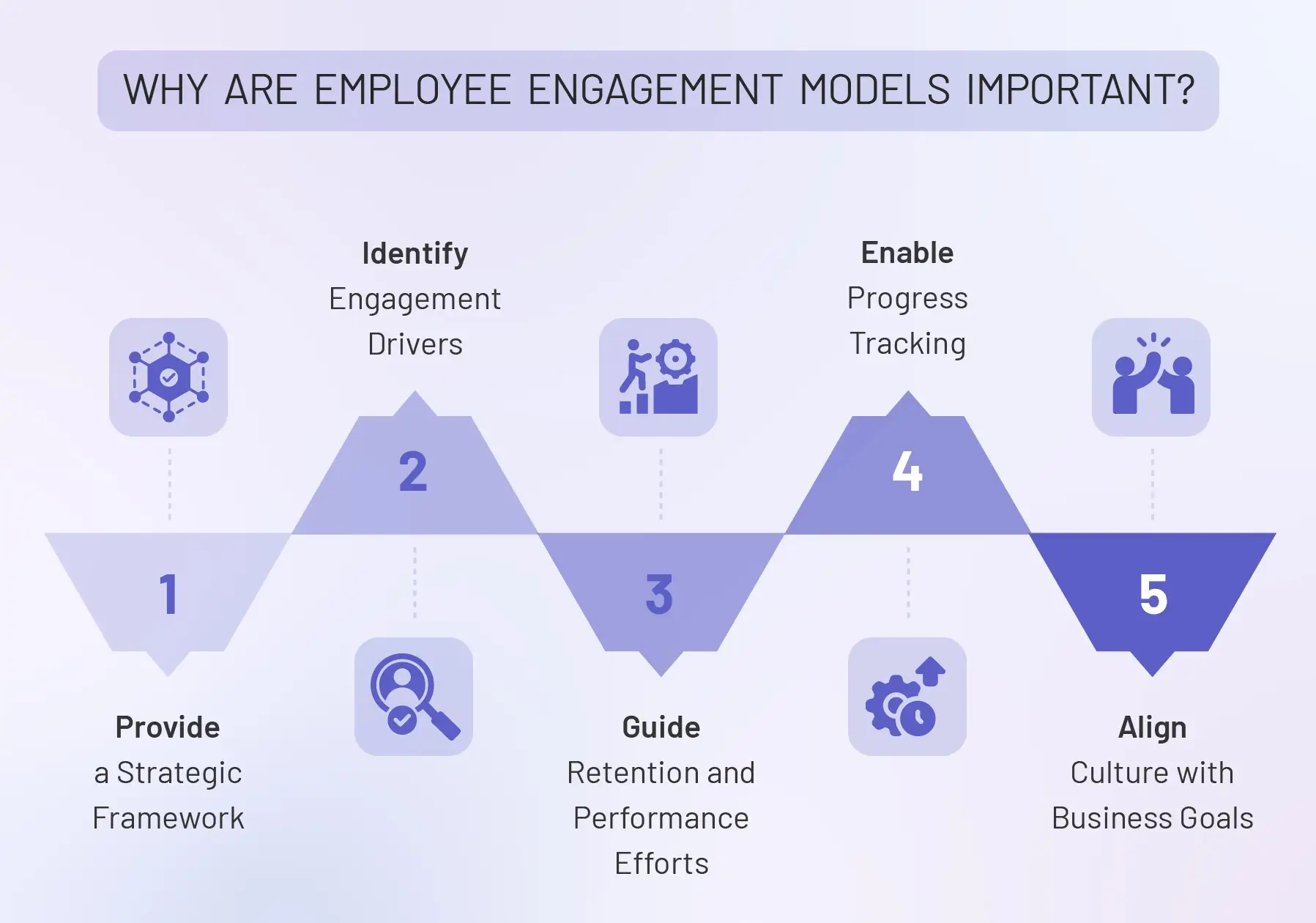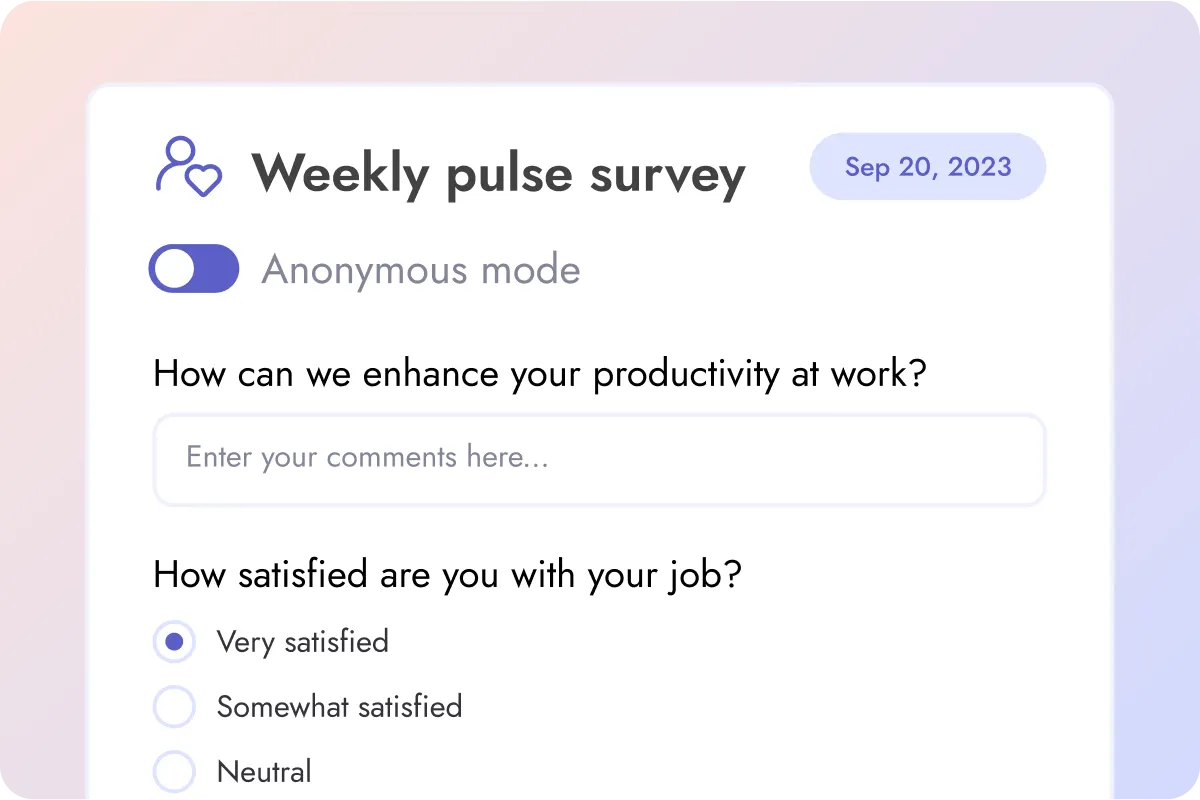The fast paced nature of life that we live in obviously heavily impacts our workplaces and organizations in turn have deeply changed the way they approach their most valuable asset: their people. With various work models and generational differences creating diverse workplace expectations, the talent shortage is more obvious now more than ever.
The results are in. Disengaged employees cost companies billions each year in lost productivity and increased turnover, not to mention the impact of such talent circulation on customer satisfaction. Still companies are struggling in engaging their workforce in a way that satisfies their needs.
That is exactly why we need employee engagement models. They provide a strategic foundations and transforms your efforts into structured and deliberate approaches into your company's engagement levels. So without further ado, let's get into it.
Employee engagement models are frameworks that allow to create a structured plan and strategize employee engagement efforts within an organization. Put simply, they clearly outline various elements like leadership communication recognition and growth that impact employees' commitment to their work and company, fostering a high-performance culture.

Employee engagement models are important because they provide a framework that is structured and strategic enough to outline clearly how employee engagement efforts are rolled out through an organization. They help not only identify what drives engagement and pinpoint key factors that go into it, they also improve retention and performance through guiding strategic action.
These models also offer a roadmap for measuring and tracking progress while aligning culture with business goals, ensuring the workplace supports high-performing teams and agile performance management practices.
Now that we have the very basics covered when it comes to employee engagement models, let's take a look the top 6 employee engagement models a little bit closer.
The Zinger model, named after its developer David Zinger, utilizes a 14-element pyramid that outlines how engagement is built from the ground up, each step of the way. It focuses on personal responsibility, meaningful work, connection with others, and results.
The main idea behind this is to combine individual drive and strong relationships with a holistic engagement experience through clear goals.
The Gallup Q12 model as its name suggests, bases its approach from 12 core questions that aim to identify what employees need in order to feel truly engaged.
The questions include;
The key point behind this model is to have practical and measurable indicators that drive engagement, especially when it comes to support, recognition and purpose within an organization.
This model on the other hand defines employee engagement via the Say, Stay and Strive approach. But what does this really mean?
The idea is that engagement is actually the balance between attitude, loyalty and effort which are all influenced by the culture leadership and HR Practices within an organization. Through this perspective, the AON-Hewitt model identifies employee engagement trends and support matrix organization structures within a company.
Developed by William Kahn, this model is the foundational model of engagement theory. It defines employee engagement via three main psychological conditions: meaningfulness, safety, and availability.
This idea basically outlines that employee engagement comes down to feeling that the work itself matters, that there is safety within one's work and having the physical and emotional capacity to engage. According to this model of employee engagement people are most involved when they find personal value, feel safe, and are energized.
This model on the other hand is adapted from Maslow's hierarchy of needs, outlining the five levels of needs apply to employee motivation all the same.
The list goes as follows;
Employees must have these needs met to fully engage and grow, helping to identify high-potential employees.
Last but not least, the JD-R Model AKA job demands-resources model balances demand with resources as you can already tell by the name. It basically requires resources to at least meet or exceed demands and that way engagement can rise.
If you on the other hand find that demands outweigh the resources, burnout hence increases. The key idea behind this model is that engagement is maintained by managing stress and boosting support to the workforce.
Key factors typically considered in this model include:
When these elements are balanced well, employees are more likely to stay engaged and productive.
Sure, we've looked into the top 6 models, but how do you know which model is right for you? Here's the thing.
So, how can you implement an employee engagement model of your choosing? What better way than to utilize the employee engagement tool designed specifically for Microsoft Teams? Teamflect can assist you on any level that you need and we'll take you through each step right now.

Running consistent employee engagement surveys are a huge part of gathering feedback and the necessary data to guide you in your employee engagement model design. With the information you collect from you most valuable asset, your workforce, you can begin to understand exactly what your employees need and get started on picking out the right model. With Teamflect's survey model you can;
Implement surveys as a regular practice and see the results for yourself!
.webp)
Don't just collect feedback but put that information to use and balance the information with 1-on-1 discussions to better articulate your employees' needs. Utilize Teamflect meeting feature and;
With features like these, you can ensure that all the data you collect isn't wasted but optimized in the most effective way possible. This module specifically allows you to clearly communicate and structure your employee engagement plan within your organization through Teamflect’s one-on-one system.
.webp)
Teamflect has always been proud of its performance management capabilities and a big part of that is the OKR module. As you keep collecting detailed information on your employees' engagement status you're also going to have to implement your insights at every level as best you can. Utilizing the OKR module you can;
All of which will help give your workforce the right workplace to know they are valued, heard and invested in which will allow your employee engagement models to fulfill their true purpose.
Last but not least, we cannot stress this step enough, keep adapting your employee engagement models as you keep on your way. Like with anything in life, the business world is full of challenges and curveballs and new developments within industries every day. To keep up to date, the best strategy is to consistently keep monitoring progress and learning from your findings and implement necessary changes in a timely manner.
Follow this path consistently and nothing is in your way to creating a workplace that any employee would want to work at.
Having a structured approach at any level of your business is non-negotiable if you're looking to stay competitive in such a fast-paced world. And employee engagement is such a huge part of successful organizations that implementing employee engagement models can never be just a nice to have. So let's take a look at exactly why that is from a few different angels!
We've already discussed in this article what employee engagement models bring to the table but let's wrap it up once again. First and foremost, employee engagement models offer a clear structure and roadmap that allow targeted action. This creates room for better measurement where companies can make much better, data-driven decisions.
That way, organizations have the right space and resources to improve performance and retention over time and create stronger strategy alignment. This is what ensures consistency across teams and helps ensure each team within strive for the same organizational goals.
To create your custom framework, you can basically follow how the same steps we went through with choosing from the models mentioned. Always start by defining what you need and what engagement means to you. That way you'll have a clear starting point on identifying your key drivers whether that is leadership quality or recognition.
Once you have that settled, you can create the pillar categories that you're looking to follow and use these groups to assign measurable indicators to. Then you'll need to align business goals and clearly communicate your framework with the workforce.
The only thing left after this point is to keep monitoring, keep reviewing and refining regularly to ensure you're up to date in your methods and are striving for your organizational objectives.
When creating a custom framework that caters to your needs the best, you can also look into the models we've already discussed and pick and choose the elements within these models that you believe will benefit you the most.
Once you've identified the strengths, you can continue to create your model as we just described. Create pillars, group them, assign indicator and start measuring and adapting as you keep going. Follow through with your employee engagement model consistently, and you are guaranteed to see the results!
An all-in-one performance management tool for Microsoft Teams
